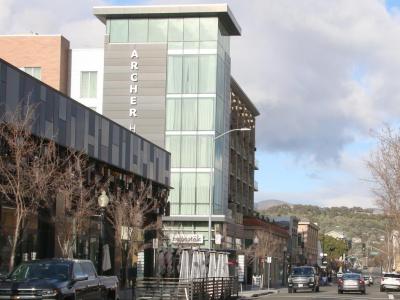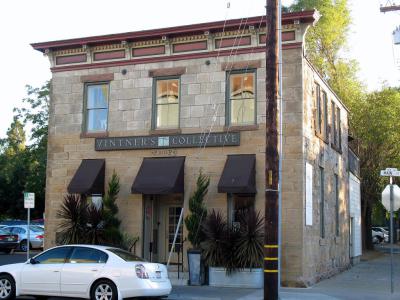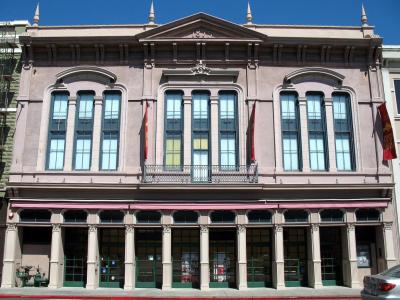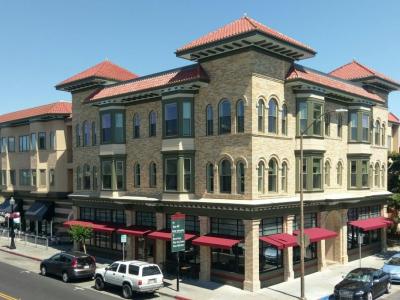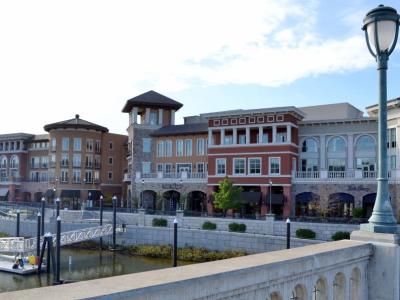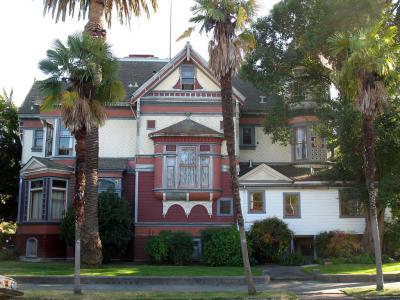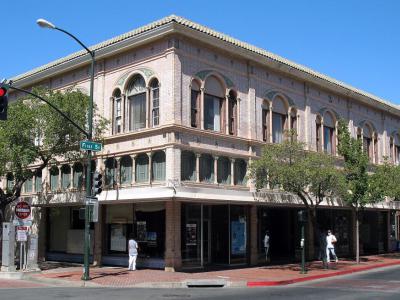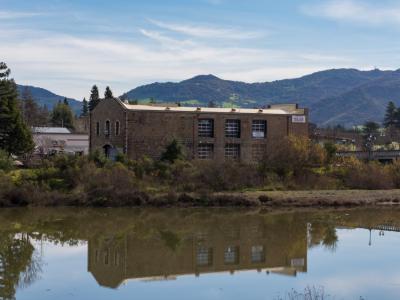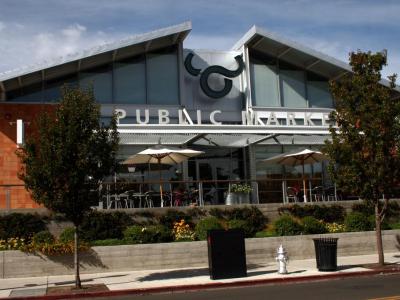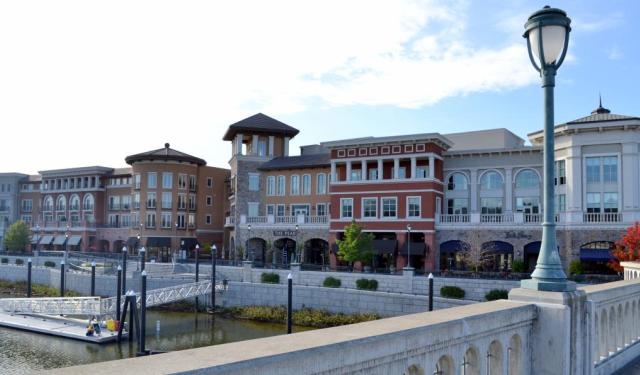
Napa Introduction Walking Tour (Self Guided), Napa
Napa, California, is a name that immediately brings to mind vineyards, world-class wines, and rolling hills bathed in golden sunlight. Indeed, this place is known worldwide as a cornerstone of Northern California’s Wine Country for a reason. But beyond the wine, the city has a history that stretches far before grapevines took over the valley. The name “Napa” comes from the Native American people, who lived in the region long before European settlers arrived in the early 19th century. The word is believed to mean “house” or “motherland.”
Napa's development took off during the mid-1800s, with the Gold Rush bringing waves of settlers seeking fortune—if not in gold, then in fertile land. Founded by Nathan Coombs in 1847, Napa quickly became a commercial hub, with river navigation and industries like ranching, lumber, and silver mining booming during the Gold Rush. The first commercial winery opened in 1859, and the Napa Valley Register newspaper launched in 1863.
Chinese laborers arrived in the late 19th century, contributing to mining and agriculture. Sam Kee Laundry remains a quiet reminder of the city’s once-thriving Chinese immigrant community.
Incorporated in the 1870s, the city thrived into the 20th century, with railroads and technological innovations. Despite challenges like earthquakes and wildfires, Napa remains a vibrant mix of history and modern attractions.
Main Street is the heart of the city, where commerce, culture, and everyday life converge. A walk along Napa’s Riverfront today reveals a mix of old and new, where historic buildings have been carefully integrated into a lively modern district full of restaurants, boutique shops, and scenic waterfront views.
First Street Napa, now a premier shopping and dining hub, also adds a contemporary touch to the historic fabric of the city, offering an upscale experience that complements the area’s heritage.
A few blocks away, the Robert Mondavi Arch and Tower Winery honors one of the most influential figures in Napa Valley’s winemaking history, a name synonymous with the region’s rise to global fame. For a taste of Napa’s culinary side, Oxbow Public Market serves as a vibrant gathering place, where artisan food vendors showcase the best of the valley’s flavors.
Whether you’re here for the wine, the history, or just a relaxing getaway, Napa offers something for everyone. Stroll through its streets, explore its past, and savor the present—because in Napa, every corner has a story waiting to be uncovered.
Napa's development took off during the mid-1800s, with the Gold Rush bringing waves of settlers seeking fortune—if not in gold, then in fertile land. Founded by Nathan Coombs in 1847, Napa quickly became a commercial hub, with river navigation and industries like ranching, lumber, and silver mining booming during the Gold Rush. The first commercial winery opened in 1859, and the Napa Valley Register newspaper launched in 1863.
Chinese laborers arrived in the late 19th century, contributing to mining and agriculture. Sam Kee Laundry remains a quiet reminder of the city’s once-thriving Chinese immigrant community.
Incorporated in the 1870s, the city thrived into the 20th century, with railroads and technological innovations. Despite challenges like earthquakes and wildfires, Napa remains a vibrant mix of history and modern attractions.
Main Street is the heart of the city, where commerce, culture, and everyday life converge. A walk along Napa’s Riverfront today reveals a mix of old and new, where historic buildings have been carefully integrated into a lively modern district full of restaurants, boutique shops, and scenic waterfront views.
First Street Napa, now a premier shopping and dining hub, also adds a contemporary touch to the historic fabric of the city, offering an upscale experience that complements the area’s heritage.
A few blocks away, the Robert Mondavi Arch and Tower Winery honors one of the most influential figures in Napa Valley’s winemaking history, a name synonymous with the region’s rise to global fame. For a taste of Napa’s culinary side, Oxbow Public Market serves as a vibrant gathering place, where artisan food vendors showcase the best of the valley’s flavors.
Whether you’re here for the wine, the history, or just a relaxing getaway, Napa offers something for everyone. Stroll through its streets, explore its past, and savor the present—because in Napa, every corner has a story waiting to be uncovered.
How it works: Download the app "GPSmyCity: Walks in 1K+ Cities" from Apple App Store or Google Play Store to your mobile phone or tablet. The app turns your mobile device into a personal tour guide and its built-in GPS navigation functions guide you from one tour stop to next. The app works offline, so no data plan is needed when traveling abroad.
Napa Introduction Walking Tour Map
Guide Name: Napa Introduction Walking Tour
Guide Location: USA » Napa (See other walking tours in Napa)
Guide Type: Self-guided Walking Tour (Sightseeing)
# of Attractions: 12
Tour Duration: 2 Hour(s)
Travel Distance: 2.9 Km or 1.8 Miles
Author: nataly
Sight(s) Featured in This Guide:
Guide Location: USA » Napa (See other walking tours in Napa)
Guide Type: Self-guided Walking Tour (Sightseeing)
# of Attractions: 12
Tour Duration: 2 Hour(s)
Travel Distance: 2.9 Km or 1.8 Miles
Author: nataly
Sight(s) Featured in This Guide:
- Main Street
- Sam Kee Laundry
- Napa Valley Opera House
- Winship-Smernes Building
- Alexandria Hotel and Annex
- Napa’s Riverfront
- George E. Goodman, Jr. House
- First Presbyterian Church of Napa
- First Street Napa
- Gordon Building
- Robert Mondavi Arch and Tower Winery
- Oxbow Public Market
1) Main Street
Main Street in Napa is the vibrant heart of downtown, offering travelers a perfect blend of historic charm, world-class dining, boutique shopping, and picturesque riverfront views. Stretching through the city, Main Street is lined with beautifully restored buildings, some dating back to the late 19th and early 20th centuries, reflecting Napa’s rich heritage.
Food and wine enthusiasts will find Main Street a paradise, with numerous acclaimed restaurants, cafés, and tasting rooms offering the best of Napa Valley’s culinary scene. Wine lovers can sample local vintages at Vintner’s Collective, a dedicated sparkling wine lounge. For those craving something sweet, Sweetie Pies Bakery tempts visitors with freshly baked pastries. The mix of fine dining, casual eateries, and cozy tasting rooms makes Main Street a must-visit destination for every palate.
Main Street in Napa is a treasure trove of history and architectural beauty, offering visitors a glimpse into the city's storied past while seamlessly blending old-world charm with modern conveniences. A prime example of this is the Hatt Building, a historic warehouse that has been thoughtfully repurposed for contemporary use, now housing a mix of shops, restaurants, and cultural spaces.
The area’s pedestrian-friendly layout makes it perfect for leisurely strolls, allowing travelers to take in the historic facades, vibrant storefronts, and scenic river views at their own pace. Spring and fall are the best times to visit, as the weather is mild and the crowds are smaller, making it easier to enjoy the lively yet relaxed atmosphere of downtown Napa.
Food and wine enthusiasts will find Main Street a paradise, with numerous acclaimed restaurants, cafés, and tasting rooms offering the best of Napa Valley’s culinary scene. Wine lovers can sample local vintages at Vintner’s Collective, a dedicated sparkling wine lounge. For those craving something sweet, Sweetie Pies Bakery tempts visitors with freshly baked pastries. The mix of fine dining, casual eateries, and cozy tasting rooms makes Main Street a must-visit destination for every palate.
Main Street in Napa is a treasure trove of history and architectural beauty, offering visitors a glimpse into the city's storied past while seamlessly blending old-world charm with modern conveniences. A prime example of this is the Hatt Building, a historic warehouse that has been thoughtfully repurposed for contemporary use, now housing a mix of shops, restaurants, and cultural spaces.
The area’s pedestrian-friendly layout makes it perfect for leisurely strolls, allowing travelers to take in the historic facades, vibrant storefronts, and scenic river views at their own pace. Spring and fall are the best times to visit, as the weather is mild and the crowds are smaller, making it easier to enjoy the lively yet relaxed atmosphere of downtown Napa.
2) Sam Kee Laundry
The Sam Kee Laundry Building, also known as the Pfeiffer Building, is one of the most historically significant structures in Napa. Built in 1875, it holds the distinction of being the oldest stone commercial building in Napa, originally constructed as part of Barth’s Bavarian Brewery, which is believed to be Napa’s first brewery. Over the years, the building has served many purposes, including housing a boarding house, saloon, brothel, meat market, and a laundry business.
In 1937, Sam Kee moved his laundry business into the space, marking an important chapter in Napa’s Chinese-American history. Sam Kee’s laundry business was involved in a series of legal cases challenging “nuisance laws” that were often used to target Chinese-owned businesses. Although the Chinese Exclusion Act was not repealed until 1943, these early legal battles contributed to the slow dismantling of discriminatory laws. The building remained a laundry until 1977, when it was the last remaining remnant of Napa’s once-thriving Chinatown.
Today, the Sam Kee Laundry Building is home to Vintner’s Collective, a wine tasting room that showcases some of Napa Valley’s most prestigious boutique wineries. As Napa’s first multi-winery tasting space, Vintner’s Collective offers an intimate and personalized wine experience, allowing visitors to sample exceptional, small-production wines in a setting rich with history and architectural charm.
The building was added to the National Register of Historic Places in 1974, preserving its rich and complex past. Over the years, the structure has faced challenges, including significant damage from the 2014 South Napa Earthquake, but it was carefully restored and reopened in 2015. With its false-front Italianate design, locally quarried sandstone, and storied past, the building remains a living testament to Napa’s layered history, blending cultural heritage, commerce, and architectural beauty in the heart of downtown.
In 1937, Sam Kee moved his laundry business into the space, marking an important chapter in Napa’s Chinese-American history. Sam Kee’s laundry business was involved in a series of legal cases challenging “nuisance laws” that were often used to target Chinese-owned businesses. Although the Chinese Exclusion Act was not repealed until 1943, these early legal battles contributed to the slow dismantling of discriminatory laws. The building remained a laundry until 1977, when it was the last remaining remnant of Napa’s once-thriving Chinatown.
Today, the Sam Kee Laundry Building is home to Vintner’s Collective, a wine tasting room that showcases some of Napa Valley’s most prestigious boutique wineries. As Napa’s first multi-winery tasting space, Vintner’s Collective offers an intimate and personalized wine experience, allowing visitors to sample exceptional, small-production wines in a setting rich with history and architectural charm.
The building was added to the National Register of Historic Places in 1974, preserving its rich and complex past. Over the years, the structure has faced challenges, including significant damage from the 2014 South Napa Earthquake, but it was carefully restored and reopened in 2015. With its false-front Italianate design, locally quarried sandstone, and storied past, the building remains a living testament to Napa’s layered history, blending cultural heritage, commerce, and architectural beauty in the heart of downtown.
3) Napa Valley Opera House
The Napa Valley Opera House, built in 1879, is one of Napa’s most significant historic landmarks and a premier venue for performing arts in the region. Located in downtown Napa, the Italianate-style building has been an integral part of the city's cultural scene since it first opened its doors on February 13, 1880, with a performance of HMS Pinafore. At the time, Napa had a population of only 5,000 people, yet the opera house quickly became a hub for entertainment. Despite closing in 1914 and remaining vacant for decades, the building was recognized for its historical importance and was added to the National Register of Historic Places in 1973.
Today, the Napa Valley Opera House hosts an array of concerts, theatrical performances, dance shows, and community arts events. The JaM Cellars Ballroom, located within the opera house, is a 650-person venue that accommodates both seated theater-style and open-floor concerts, featuring top-tier artists in rock, pop, country, and jazz.
The venue is also a key location for BottleRock Napa Valley AfterDark performances, providing an intimate space for both international headliners and emerging talent. The carefully restored red and gold façade, curving staircase, and second-floor balcony preserve the grandeur of the original structure, while state-of-the-art sound and stage equipment ensure a modern concert experience.
On the first floor, visitors can enjoy Blue Note Napa, a renowned jazz club, restaurant, and bar that brings world-class jazz performances to an intimate setting. Legends like Michael Bublé, Diana Krall, and Chris Botti have graced its stage, making it one of the most sought-after spots for jazz lovers in Napa. Guests can indulge in a diverse menu featuring Thai, Korean, Mediterranean, and American cuisine, paired with expertly crafted cocktails.
Today, the Napa Valley Opera House hosts an array of concerts, theatrical performances, dance shows, and community arts events. The JaM Cellars Ballroom, located within the opera house, is a 650-person venue that accommodates both seated theater-style and open-floor concerts, featuring top-tier artists in rock, pop, country, and jazz.
The venue is also a key location for BottleRock Napa Valley AfterDark performances, providing an intimate space for both international headliners and emerging talent. The carefully restored red and gold façade, curving staircase, and second-floor balcony preserve the grandeur of the original structure, while state-of-the-art sound and stage equipment ensure a modern concert experience.
On the first floor, visitors can enjoy Blue Note Napa, a renowned jazz club, restaurant, and bar that brings world-class jazz performances to an intimate setting. Legends like Michael Bublé, Diana Krall, and Chris Botti have graced its stage, making it one of the most sought-after spots for jazz lovers in Napa. Guests can indulge in a diverse menu featuring Thai, Korean, Mediterranean, and American cuisine, paired with expertly crafted cocktails.
4) Winship-Smernes Building
The Winship-Smernes Building is a historic two-story commercial structure built in 1888. Designed by Luther M. Turton, one of Napa’s most notable architects, the building is an excellent example of Italianate Victorian commercial architecture. Its brick façade, cast-iron detailing, and large glass storefront reflect the architectural style that defined Napa’s late 19th-century business district. Recognized for its historical and architectural significance, the Winship-Smernes Building was listed on the National Register of Historic Places in 1977. Over the years, it has also been referred to as the Hennessey Building.
Situated near the First Street Bridge over the Napa River, the Winship-Smernes Building has long stood at the heart of Napa’s commercial center. Its origins trace back to E.A. Winship, who arrived in Napa from Minneapolis in 1887 and quickly became a prominent figure in town. Winship purchased the property for $15,000 in March 1888 and soon after announced plans for a substantial brick building. His investment reflected the economic optimism of the period, as Napa was growing into a thriving hub for business and trade.
Today, the Winship-Smernes Building remains an important landmark in downtown Napa, showcasing the enduring charm of its Victorian Italianate architecture. While its original function has evolved over the years, the building continues to contribute to the city’s historic and commercial landscape.
Situated near the First Street Bridge over the Napa River, the Winship-Smernes Building has long stood at the heart of Napa’s commercial center. Its origins trace back to E.A. Winship, who arrived in Napa from Minneapolis in 1887 and quickly became a prominent figure in town. Winship purchased the property for $15,000 in March 1888 and soon after announced plans for a substantial brick building. His investment reflected the economic optimism of the period, as Napa was growing into a thriving hub for business and trade.
Today, the Winship-Smernes Building remains an important landmark in downtown Napa, showcasing the enduring charm of its Victorian Italianate architecture. While its original function has evolved over the years, the building continues to contribute to the city’s historic and commercial landscape.
5) Alexandria Hotel and Annex
The Alexandria Hotel and Annex is a striking example of Mission Revival architecture, dating back to circa 1900-1910. The three-story brick structure features distinctive metal tile roofs, an unusual material believed to be made of tungsten. The hotel's two street-facing facades are identical on the top two floors, showcasing three square corner towers that emphasize its grandeur. Overhanging eaves, supported by modillions and dentils, add to the building's intricate detailing. The arched brick hood molds over the windows and the string courses dividing the towers into sections further enhance the structure’s architectural significance.
At some point, the adjacent building was annexed to the hotel and was redesigned to seamlessly match the original structure. The Annex, which actually predates the hotel, underwent significant modifications to integrate its façade with the main building, including the addition of a tile roof with modillions and dentils, as well as a matching string course. Notable features of both structures include arched and round-headed windows, wrought iron balconies, and a series of transoms above large plate glass windows.
The first floor of the hotel is marked by flat brick pilasters with Doric capitals, separating large plate glass windows and twelve-light transoms, which were once made of leaded glass in an elongated diamond pattern. The Annex, housing two separate shops, features matching transoms, pilasters, and glazed tile, ensuring visual harmony between the two buildings. The hotel’s wrought iron fire escapes, though not original, add a historic charm.
At some point, the adjacent building was annexed to the hotel and was redesigned to seamlessly match the original structure. The Annex, which actually predates the hotel, underwent significant modifications to integrate its façade with the main building, including the addition of a tile roof with modillions and dentils, as well as a matching string course. Notable features of both structures include arched and round-headed windows, wrought iron balconies, and a series of transoms above large plate glass windows.
The first floor of the hotel is marked by flat brick pilasters with Doric capitals, separating large plate glass windows and twelve-light transoms, which were once made of leaded glass in an elongated diamond pattern. The Annex, housing two separate shops, features matching transoms, pilasters, and glazed tile, ensuring visual harmony between the two buildings. The hotel’s wrought iron fire escapes, though not original, add a historic charm.
6) Napa’s Riverfront (must see)
Napa’s Riverfront is a premier destination in downtown Napa, offering a blend of fine dining, shopping, entertainment, and luxury accommodations along the scenic Napa River. Located between Third and Fifth Streets on South Main, this vibrant area is home to the Riverfront Building and the historic Napa Mill, two iconic landmarks that contribute to its charm and appeal.
Whether visitors are looking for world-class cuisine, boutique shopping, or a relaxing riverside experience, Napa’s Riverfront provides a quintessential Napa Valley experience in an elegant and inviting setting. The Riverfront district is known for hosting some of downtown Napa’s most celebrated restaurants and shops. Food enthusiasts can enjoy renowned dining spots such as Morimoto Napa, known for its innovative Japanese cuisine, and The Waterfront Seafood Grill, offering fresh, locally sourced seafood in a refined setting.
Visitors can also explore boutique stores like Shoppe Twelve, which features stylish apparel and unique finds. With a mix of both modern and historic elements, Napa’s Riverfront seamlessly blends the area’s rich history with contemporary luxury.
Beyond dining and shopping, Napa’s Riverfront offers elegant accommodations and a picturesque setting perfect for strolling along the river. The luxurious Riverfront Residences provide an exclusive living experience with stunning views and upscale amenities. Meanwhile, the historic Napa Mill adds to the area’s charm, preserving a piece of Napa’s heritage while serving as a lively hub for visitors.
Whether visitors are looking for world-class cuisine, boutique shopping, or a relaxing riverside experience, Napa’s Riverfront provides a quintessential Napa Valley experience in an elegant and inviting setting. The Riverfront district is known for hosting some of downtown Napa’s most celebrated restaurants and shops. Food enthusiasts can enjoy renowned dining spots such as Morimoto Napa, known for its innovative Japanese cuisine, and The Waterfront Seafood Grill, offering fresh, locally sourced seafood in a refined setting.
Visitors can also explore boutique stores like Shoppe Twelve, which features stylish apparel and unique finds. With a mix of both modern and historic elements, Napa’s Riverfront seamlessly blends the area’s rich history with contemporary luxury.
Beyond dining and shopping, Napa’s Riverfront offers elegant accommodations and a picturesque setting perfect for strolling along the river. The luxurious Riverfront Residences provide an exclusive living experience with stunning views and upscale amenities. Meanwhile, the historic Napa Mill adds to the area’s charm, preserving a piece of Napa’s heritage while serving as a lively hub for visitors.
7) George E. Goodman, Jr. House
The George E. Goodman, Jr. House, now known as The George, is a stunning late 19th-century mansion in downtown Napa, California. Built in 1891 and listed on the National Register of Historic Places, this historic residence was originally commissioned by George E. Goodman Jr. and remains a remarkable example of refined architectural beauty. Its dove gray façade and intricate ornamentation reflect the grandeur of the Victorian era, while the lush surroundings, including towering palm trees, create an oasis of tranquility within the bustling heart of Napa. This boutique property, meticulously restored, offers a luxurious and intimate retreat for visitors seeking a blend of history and modern elegance.
Inside, The George has been transformed into a sophisticated boutique inn, featuring just nine uniquely designed rooms that merge historic charm with contemporary comfort. Each space is carefully curated, preserving elements of the home's original grandeur while introducing modern amenities that cater to the highest standards of hospitality. The result is a setting where guests can immerse themselves in the past without sacrificing the indulgences of the present. Whether admiring the craftsmanship of the home's original details or enjoying a plush and relaxing stay, visitors are treated to an experience that is both lavish and inviting.
Beyond its architectural charm, The George offers an unparalleled location, placing guests within walking distance of Napa’s finest attractions. From morning strolls along the Napa River to evening dining at renowned establishments like Angèle and Morimoto, the surrounding area is filled with delightful discoveries.
Inside, The George has been transformed into a sophisticated boutique inn, featuring just nine uniquely designed rooms that merge historic charm with contemporary comfort. Each space is carefully curated, preserving elements of the home's original grandeur while introducing modern amenities that cater to the highest standards of hospitality. The result is a setting where guests can immerse themselves in the past without sacrificing the indulgences of the present. Whether admiring the craftsmanship of the home's original details or enjoying a plush and relaxing stay, visitors are treated to an experience that is both lavish and inviting.
Beyond its architectural charm, The George offers an unparalleled location, placing guests within walking distance of Napa’s finest attractions. From morning strolls along the Napa River to evening dining at renowned establishments like Angèle and Morimoto, the surrounding area is filled with delightful discoveries.
8) First Presbyterian Church of Napa
The First Presbyterian Church of Napa, established in 1853, is one of the oldest and most historically significant churches in Napa. The congregation began as a small group of worshipers meeting in the Napa County Courthouse before moving into their first dedicated church building on Randolph Street in 1857, on land donated by Nathan Coombs.
As the church grew, a larger Neo-Gothic style structure was completed in 1874, becoming a landmark in downtown Napa. The building features soaring ceilings, intricate woodwork, and beautiful stained glass windows, exemplifying Gothic Revival architecture. The church was added to the National Register of Historic Places in 1975 and continues to be an integral part of the community, providing worship services, Bible studies, youth programs, and outreach initiatives.
Over the years, First Presbyterian Church has faced challenges, most notably the 2014 South Napa earthquake, which caused significant damage to the historic structure. While the building remained structurally sound, extensive repairs were required, including seismic retrofitting, stained glass restoration, wall and flooring repairs, and the installation of upgraded fire and security systems. In July 2016, after two years of restoration work, the church reopened its sanctuary, allowing worship services to resume in the beloved space.
As the church grew, a larger Neo-Gothic style structure was completed in 1874, becoming a landmark in downtown Napa. The building features soaring ceilings, intricate woodwork, and beautiful stained glass windows, exemplifying Gothic Revival architecture. The church was added to the National Register of Historic Places in 1975 and continues to be an integral part of the community, providing worship services, Bible studies, youth programs, and outreach initiatives.
Over the years, First Presbyterian Church has faced challenges, most notably the 2014 South Napa earthquake, which caused significant damage to the historic structure. While the building remained structurally sound, extensive repairs were required, including seismic retrofitting, stained glass restoration, wall and flooring repairs, and the installation of upgraded fire and security systems. In July 2016, after two years of restoration work, the church reopened its sanctuary, allowing worship services to resume in the beloved space.
9) First Street Napa (must see)
First Street Napa is a vibrant shopping, dining, and lifestyle destination located in the heart of downtown Napa. This walkable and engaging district brings together innovative merchants, renowned chefs, and world-class tasting rooms, offering visitors a refined yet relaxed experience.
With a focus on quality and uniqueness, First Street Napa serves as a hub for both locals and visitors looking to immerse themselves in the best of Napa Valley’s culture. The mix of culinary excellence, boutique shopping, and artistic expression makes it an essential stop for those seeking both luxury and local charm.
While the shopping area features well-known international brands like Anthropologie, Free People, Lululemon, and Charlie Palmer Steak, its heart lies in its support of smaller, independent retailers. Many of these merchants are Napa Valley natives, offering thoughtfully curated selections that reflect the region’s artisanal spirit.
Visitors can explore specialty boutiques featuring premium denim, home and garden furnishings, children’s clothing, and handcrafted goods from both local artisans and international designers. This blend of global sophistication and local craftsmanship creates a unique and diverse shopping experience that captures the essence of Napa Valley.
Beyond its retail and dining offerings, First Street Napa is designed as a gathering place that seamlessly integrates art, community, and relaxation. The district’s inviting outdoor patios, locally curated artwork, and the centerpiece fire pit provide a warm and welcoming atmosphere for socializing and unwinding.
With a focus on quality and uniqueness, First Street Napa serves as a hub for both locals and visitors looking to immerse themselves in the best of Napa Valley’s culture. The mix of culinary excellence, boutique shopping, and artistic expression makes it an essential stop for those seeking both luxury and local charm.
While the shopping area features well-known international brands like Anthropologie, Free People, Lululemon, and Charlie Palmer Steak, its heart lies in its support of smaller, independent retailers. Many of these merchants are Napa Valley natives, offering thoughtfully curated selections that reflect the region’s artisanal spirit.
Visitors can explore specialty boutiques featuring premium denim, home and garden furnishings, children’s clothing, and handcrafted goods from both local artisans and international designers. This blend of global sophistication and local craftsmanship creates a unique and diverse shopping experience that captures the essence of Napa Valley.
Beyond its retail and dining offerings, First Street Napa is designed as a gathering place that seamlessly integrates art, community, and relaxation. The district’s inviting outdoor patios, locally curated artwork, and the centerpiece fire pit provide a warm and welcoming atmosphere for socializing and unwinding.
10) Gordon Building
The Gordon Building of Napa, a historic Spanish Colonial Revival commercial structure, stands as a remarkable example of preservation and rehabilitation. Originally built as a two-story commercial building on Napa’s main shopping street, it was severely damaged during the 2014 South Napa earthquake, which caused interior and exterior walls to collapse, roof disconnections, and extensive structural failures. Despite the significant damage, the building's steel skeleton played a crucial role in preventing a complete collapse. However, the decorative terra cotta masonry, ornamental ironwork, and intricate plaster finishes suffered substantial destruction, leading to the building being red-tagged as unsafe for occupancy.
Following extensive structural assessments and evaluations, a decision was made in 2016 to undertake a comprehensive rehabilitation project, focusing on both seismic retrofitting and architectural restoration. Historic elements such as the stone property line wall, ornamental ironwork, terra cotta detailing, and original wood and metal windows and doors were meticulously repaired, restoring the building’s grandeur while reinforcing its structural integrity.
In 2022, the Gordon Building was honored with the Preservation Design Award for Rehabilitation, a recognition awarded by top professionals in architecture, engineering, and historic preservation.
Following extensive structural assessments and evaluations, a decision was made in 2016 to undertake a comprehensive rehabilitation project, focusing on both seismic retrofitting and architectural restoration. Historic elements such as the stone property line wall, ornamental ironwork, terra cotta detailing, and original wood and metal windows and doors were meticulously repaired, restoring the building’s grandeur while reinforcing its structural integrity.
In 2022, the Gordon Building was honored with the Preservation Design Award for Rehabilitation, a recognition awarded by top professionals in architecture, engineering, and historic preservation.
11) Robert Mondavi Arch and Tower Winery (must see)
The Robert Mondavi Arch & Tower Winery is an elegant new tasting room and culinary experience in the heart of downtown Napa. Nestled along the riverfront in the historic Borreo Building, this boutique satellite location serves as a temporary home for the Robert Mondavi Winery while its iconic Oakville estate undergoes a multi-year renovation. Arch & Tower offers a sophisticated yet inviting space, where guests can enjoy wine tastings, food pairings, educational seminars, and exclusive special events. Visitors are welcomed with a curated selection of wines from The Estates Collection, thoughtfully paired with modern interpretations of California cuisine from the 1960s, paying homage to the winery’s founding era.
At Arch & Tower, guests can explore the To Kalon Vineyard portfolio, featuring Reserve tier wines that highlight the elegance and finesse of this legendary vineyard. Wine enthusiasts can indulge in a four-wine tasting flight while relaxing in the open-air lounge, overlooking downtown Napa’s skyline. The experience is enhanced by expert-led educational sessions, guiding visitors through the nuances of Napa Valley terroir and winemaking techniques. A three-bite pairing menu, crafted by the Robert Mondavi culinary team, elevates the tasting, blending locally sourced ingredients with international flavors. Guests can also opt for a leisurely communal lunch on the outdoor terrace, where chefs present a seasonally inspired three-course menu, expertly paired with selections from The Estates Collection.
As a pioneering force in Napa Valley winemaking, Robert Mondavi Winery continues its legacy at Arch & Tower, offering a refined yet immersive experience for visitors. Whether attending a wine-paired lunch, private event, or tasting seminar, guests will gain deeper insight into Napa Valley’s winemaking traditions.
At Arch & Tower, guests can explore the To Kalon Vineyard portfolio, featuring Reserve tier wines that highlight the elegance and finesse of this legendary vineyard. Wine enthusiasts can indulge in a four-wine tasting flight while relaxing in the open-air lounge, overlooking downtown Napa’s skyline. The experience is enhanced by expert-led educational sessions, guiding visitors through the nuances of Napa Valley terroir and winemaking techniques. A three-bite pairing menu, crafted by the Robert Mondavi culinary team, elevates the tasting, blending locally sourced ingredients with international flavors. Guests can also opt for a leisurely communal lunch on the outdoor terrace, where chefs present a seasonally inspired three-course menu, expertly paired with selections from The Estates Collection.
As a pioneering force in Napa Valley winemaking, Robert Mondavi Winery continues its legacy at Arch & Tower, offering a refined yet immersive experience for visitors. Whether attending a wine-paired lunch, private event, or tasting seminar, guests will gain deeper insight into Napa Valley’s winemaking traditions.
12) Oxbow Public Market (must see)
The Oxbow Public Market is a vibrant culinary and community hub that attracts both locals and visitors alike. Spanning 40,000 square feet, this lively marketplace offers an authentic taste of Napa Valley, featuring a diverse selection of artisanal cafés, local food vendors, and regional specialties. Open seven days a week, the market is committed to sustainable and organic agriculture, showcasing fresh produce, high-quality meats, cheeses, seafood, charcuterie, baked goods, and handcrafted products. Whether you’re searching for farm-to-table ingredients used by top Napa Valley chefs or simply looking to enjoy a relaxed meal, Oxbow Public Market provides a dynamic experience where Napa’s rich food culture thrives.
More than just a shopping destination, Oxbow Public Market serves as a community gathering place, hosting wine and beer tastings, live music, and cooking demonstrations throughout the year. Visitors can savor an array of gourmet dining options, from fresh oysters and charcuterie to tacos and wood-fired pizza, all while enjoying the scenic outdoor deck overlooking the Napa River. The market also features specialty shops selling handmade souvenirs, artisan goods, and unique home décor, making it an excellent stop for those looking to take a piece of Napa Valley home with them. Its location along the Napa River Trail makes it an easily accessible and picturesque spot to explore while immersing yourself in the region’s local flavors.
With its fresh, high-quality products, exceptional dining experiences, and strong community focus, Oxbow Public Market embodies the spirit of Napa Valley’s farm-to-table movement and remains a must-visit for food lovers, wine enthusiasts, and travelers looking to experience Napa’s vibrant local scene.
More than just a shopping destination, Oxbow Public Market serves as a community gathering place, hosting wine and beer tastings, live music, and cooking demonstrations throughout the year. Visitors can savor an array of gourmet dining options, from fresh oysters and charcuterie to tacos and wood-fired pizza, all while enjoying the scenic outdoor deck overlooking the Napa River. The market also features specialty shops selling handmade souvenirs, artisan goods, and unique home décor, making it an excellent stop for those looking to take a piece of Napa Valley home with them. Its location along the Napa River Trail makes it an easily accessible and picturesque spot to explore while immersing yourself in the region’s local flavors.
With its fresh, high-quality products, exceptional dining experiences, and strong community focus, Oxbow Public Market embodies the spirit of Napa Valley’s farm-to-table movement and remains a must-visit for food lovers, wine enthusiasts, and travelers looking to experience Napa’s vibrant local scene.
The Most Popular Cities
/ view all
